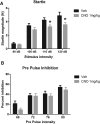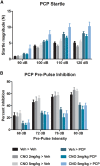Clozapine N-Oxide Administration Produces Behavioral Effects in Long-Evans Rats: Implications for Designing DREADD Experiments
- PMID: 27822508
- PMCID: PMC5089539
- DOI: 10.1523/ENEURO.0219-16.2016
Clozapine N-Oxide Administration Produces Behavioral Effects in Long-Evans Rats: Implications for Designing DREADD Experiments
Abstract
Clozapine N-oxide (CNO) is a ligand for a powerful chemogenetic system that can selectively inhibit or activate neurons; the so-called Designer Receptors Exclusively Activated by Designer Drugs (DREADD) system. This system consists of synthetic G-protein-coupled receptors, which are not believed to be activated by any endogenous ligand, but are activated by the otherwise inert CNO. However, it has previously been shown that the administration of CNO in humans and rats leads to detectable levels of the bioactive compounds clozapine and N-desmethylclozapine (N-Des). As a follow-up, experiments were conducted to investigate the effects of CNO in male Long-Evans rats. It was found that 1 mg/kg CNO reduced the acoustic startle reflex but had no effect on prepulse inhibition (PPI; a measure of sensorimotor gating). CNO (2 and 5 mg/kg) had no effect on the disruption to PPI induced by the NMDA antagonist phencyclidine or the muscarinic antagonist scopolamine. In locomotor studies, CNO alone (at 1, 2, and 5 mg/kg) had no effect on spontaneous locomotion, but 5 mg/kg CNO pretreatment significantly attenuated d-amphetamine-induced hyperlocomotion. In line with the behavioral results, fast-scan cyclic voltammetry found that 5 mg/kg CNO significantly attenuated the d-amphetamine-induced increase in evoked dopamine. However, the effects seen after CNO administration cannot be definitively ascribed to CNO because biologically relevant levels of clozapine and N-Des were found in plasma after CNO injection. Our results show that CNO has multiple dose-dependent effects in vivo and is converted to clozapine and N-Des emphasizing the need for a CNO-only DREADD-free control group when designing DREADD-based experiments.
Keywords: CNO; DREADDs; behavior; voltammetry.
Figures






References
-
- Alexander GM, Rogan SC, Abbas AI, Armbruster BN, Pei Y, Allen JA, Nonneman RJ, Hartmann J, Moy SS, Nicolelis MA, McNamara JO, Roth BL (2009) Remote control of neuronal activity in transgenic mice expressing evolved G protein-coupled receptors. Neuron 63:27–39. 10.1016/j.neuron.2009.06.014 - DOI - PMC - PubMed
-
- Alves-Rodrigues A, Leurs R, Willems E, Timmerman H (1996) Binding of clozapine metabolites and analogues to the histamine H3 receptor in rat brain cortex. Arch Pharm (Weinheim) 329:413–416. - PubMed
-
- Anderson SA, Michaelides M, Zarnegar P, Ren Y, Fagergren P, Thanos PK, Wang GJ, Bannon M, Neumaier JF, Keller E, Volkow ND, Hurd YL (2013) Impaired periamygdaloid-cortex prodynorphin is characteristic of opiate addiction and depression. J Clin Invest 123:5334–5341. 10.1172/JCI70395 - DOI - PMC - PubMed
MeSH terms
Substances
Grants and funding
LinkOut - more resources
Full Text Sources
Other Literature Sources
Research Materials
